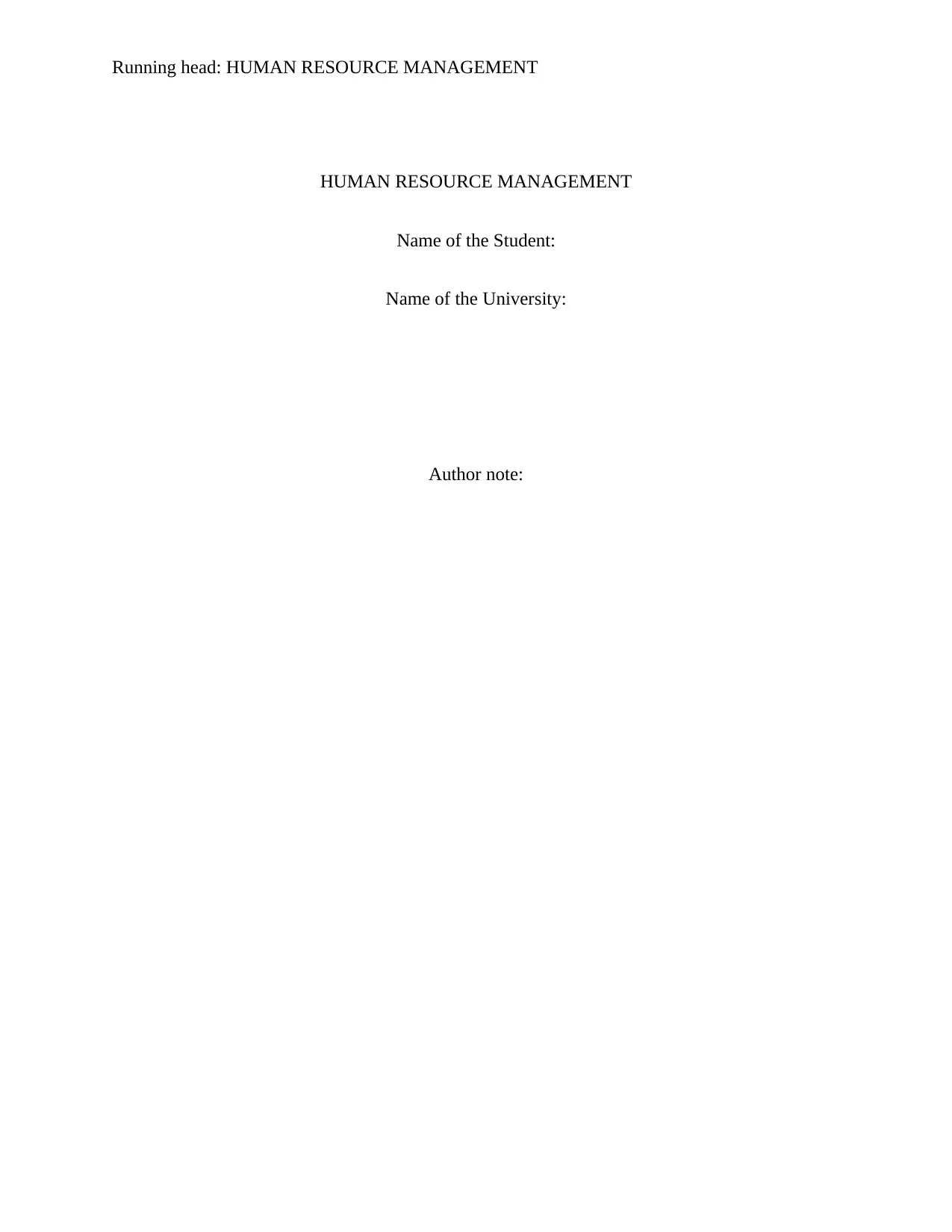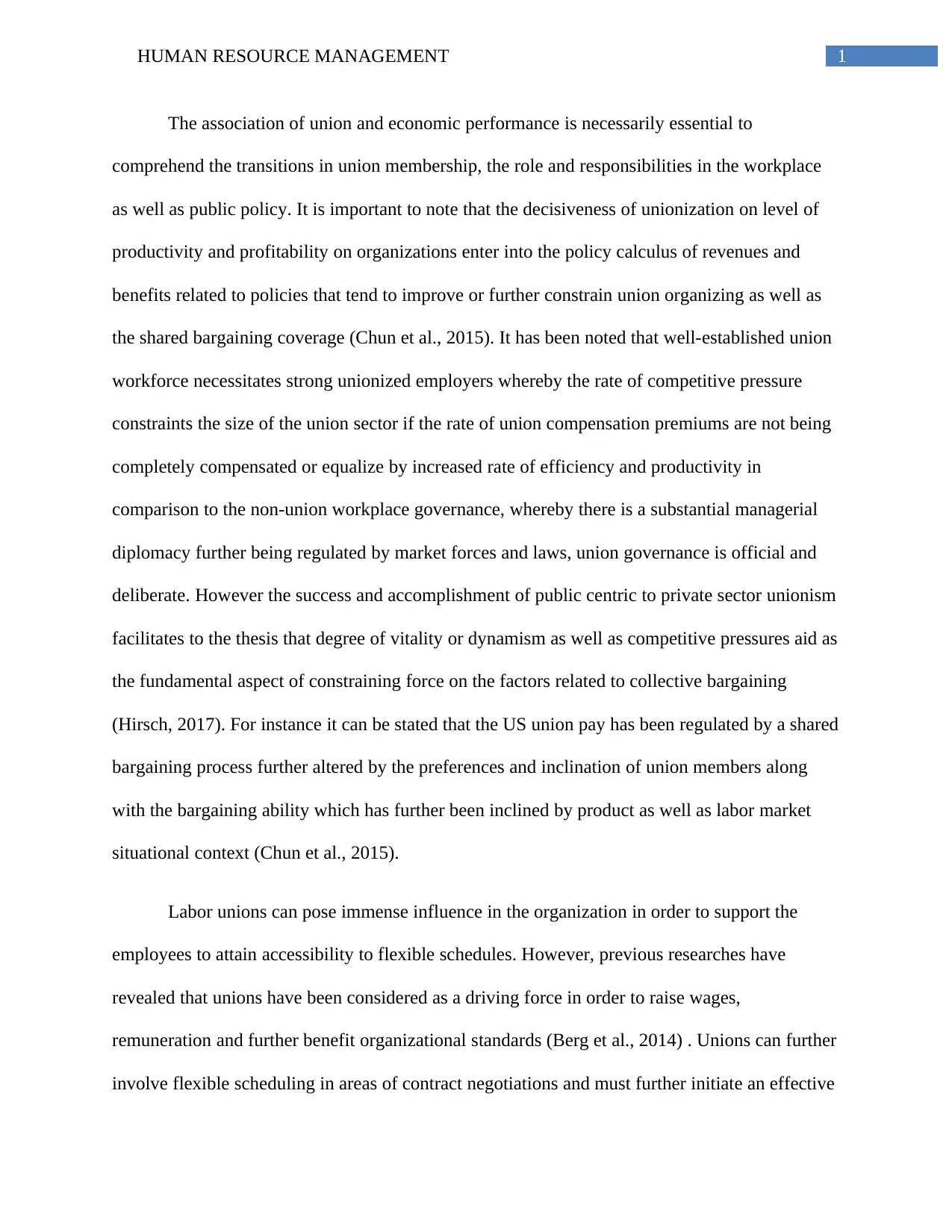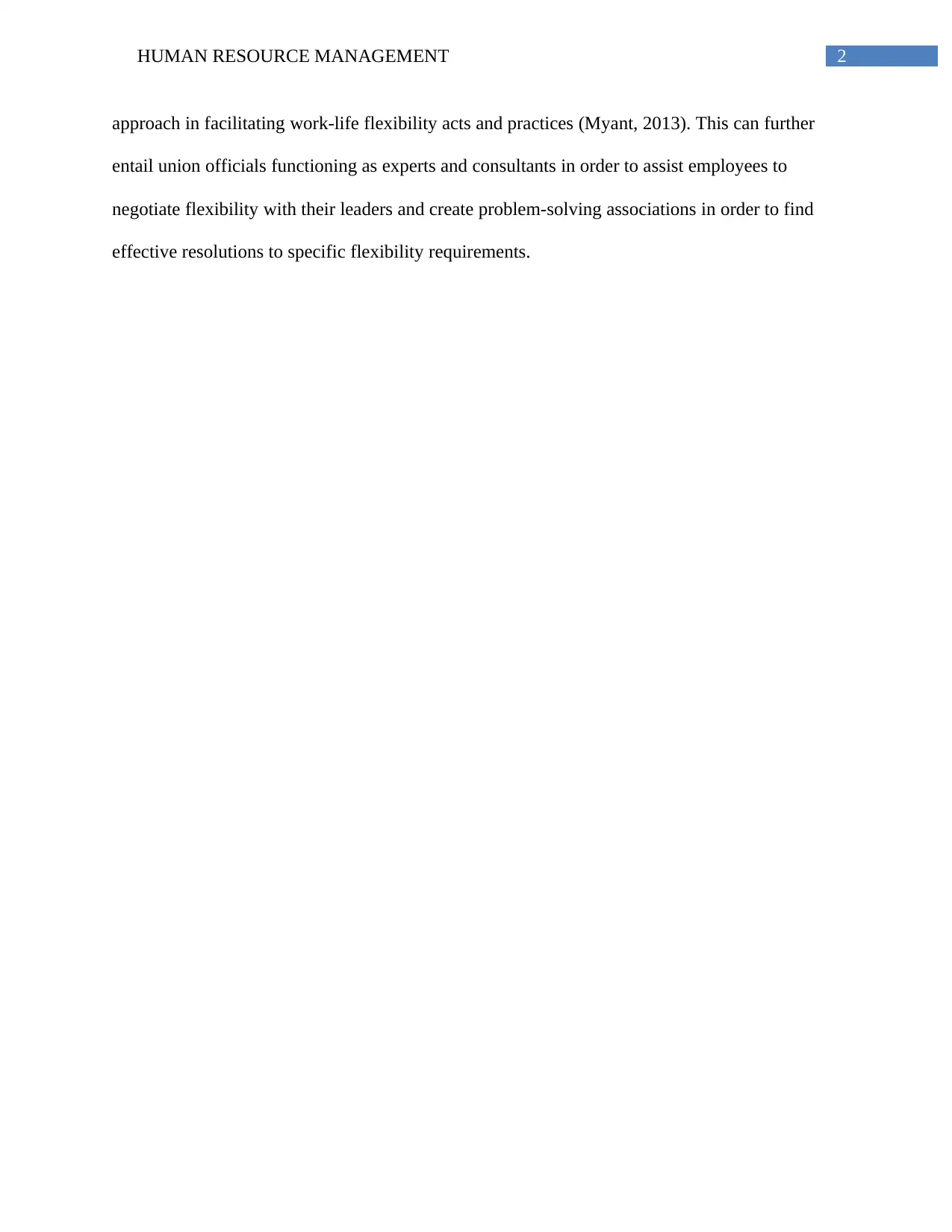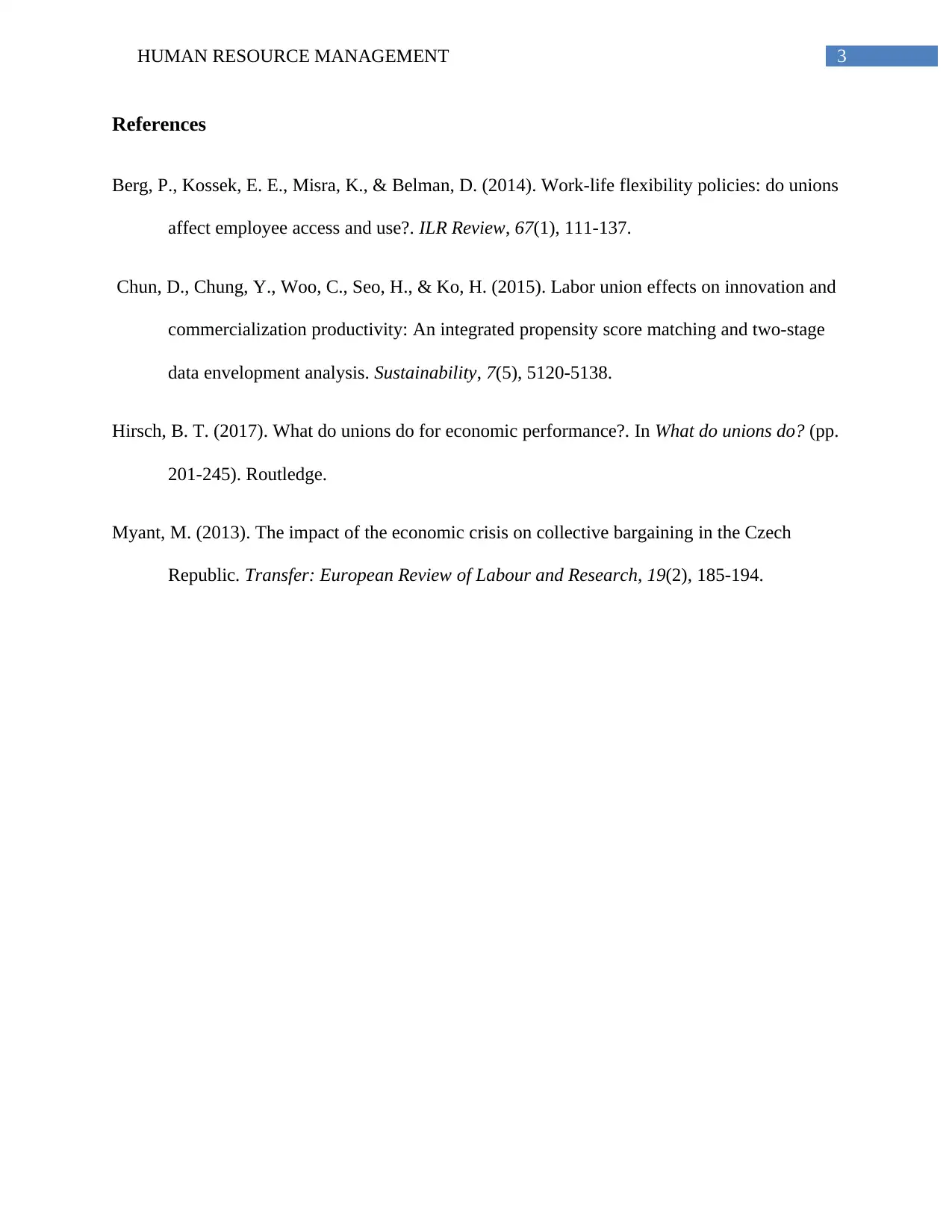The Association of Union and Economic Performance in Human Resource Management
VerifiedAdded on 2023/06/10
|4
|591
|472
AI Summary
This article discusses the association of union and economic performance in human resource management. It explores the role of unions in the workplace and public policy, and how they can influence work-life flexibility policies. The article also provides insights into the impact of unions on innovation and commercialization productivity.
Contribute Materials
Your contribution can guide someone’s learning journey. Share your
documents today.

Running head: HUMAN RESOURCE MANAGEMENT
HUMAN RESOURCE MANAGEMENT
Name of the Student:
Name of the University:
Author note:
HUMAN RESOURCE MANAGEMENT
Name of the Student:
Name of the University:
Author note:
Secure Best Marks with AI Grader
Need help grading? Try our AI Grader for instant feedback on your assignments.

1HUMAN RESOURCE MANAGEMENT
The association of union and economic performance is necessarily essential to
comprehend the transitions in union membership, the role and responsibilities in the workplace
as well as public policy. It is important to note that the decisiveness of unionization on level of
productivity and profitability on organizations enter into the policy calculus of revenues and
benefits related to policies that tend to improve or further constrain union organizing as well as
the shared bargaining coverage (Chun et al., 2015). It has been noted that well-established union
workforce necessitates strong unionized employers whereby the rate of competitive pressure
constraints the size of the union sector if the rate of union compensation premiums are not being
completely compensated or equalize by increased rate of efficiency and productivity in
comparison to the non-union workplace governance, whereby there is a substantial managerial
diplomacy further being regulated by market forces and laws, union governance is official and
deliberate. However the success and accomplishment of public centric to private sector unionism
facilitates to the thesis that degree of vitality or dynamism as well as competitive pressures aid as
the fundamental aspect of constraining force on the factors related to collective bargaining
(Hirsch, 2017). For instance it can be stated that the US union pay has been regulated by a shared
bargaining process further altered by the preferences and inclination of union members along
with the bargaining ability which has further been inclined by product as well as labor market
situational context (Chun et al., 2015).
Labor unions can pose immense influence in the organization in order to support the
employees to attain accessibility to flexible schedules. However, previous researches have
revealed that unions have been considered as a driving force in order to raise wages,
remuneration and further benefit organizational standards (Berg et al., 2014) . Unions can further
involve flexible scheduling in areas of contract negotiations and must further initiate an effective
The association of union and economic performance is necessarily essential to
comprehend the transitions in union membership, the role and responsibilities in the workplace
as well as public policy. It is important to note that the decisiveness of unionization on level of
productivity and profitability on organizations enter into the policy calculus of revenues and
benefits related to policies that tend to improve or further constrain union organizing as well as
the shared bargaining coverage (Chun et al., 2015). It has been noted that well-established union
workforce necessitates strong unionized employers whereby the rate of competitive pressure
constraints the size of the union sector if the rate of union compensation premiums are not being
completely compensated or equalize by increased rate of efficiency and productivity in
comparison to the non-union workplace governance, whereby there is a substantial managerial
diplomacy further being regulated by market forces and laws, union governance is official and
deliberate. However the success and accomplishment of public centric to private sector unionism
facilitates to the thesis that degree of vitality or dynamism as well as competitive pressures aid as
the fundamental aspect of constraining force on the factors related to collective bargaining
(Hirsch, 2017). For instance it can be stated that the US union pay has been regulated by a shared
bargaining process further altered by the preferences and inclination of union members along
with the bargaining ability which has further been inclined by product as well as labor market
situational context (Chun et al., 2015).
Labor unions can pose immense influence in the organization in order to support the
employees to attain accessibility to flexible schedules. However, previous researches have
revealed that unions have been considered as a driving force in order to raise wages,
remuneration and further benefit organizational standards (Berg et al., 2014) . Unions can further
involve flexible scheduling in areas of contract negotiations and must further initiate an effective

2HUMAN RESOURCE MANAGEMENT
approach in facilitating work-life flexibility acts and practices (Myant, 2013). This can further
entail union officials functioning as experts and consultants in order to assist employees to
negotiate flexibility with their leaders and create problem-solving associations in order to find
effective resolutions to specific flexibility requirements.
approach in facilitating work-life flexibility acts and practices (Myant, 2013). This can further
entail union officials functioning as experts and consultants in order to assist employees to
negotiate flexibility with their leaders and create problem-solving associations in order to find
effective resolutions to specific flexibility requirements.

3HUMAN RESOURCE MANAGEMENT
References
Berg, P., Kossek, E. E., Misra, K., & Belman, D. (2014). Work-life flexibility policies: do unions
affect employee access and use?. ILR Review, 67(1), 111-137.
Chun, D., Chung, Y., Woo, C., Seo, H., & Ko, H. (2015). Labor union effects on innovation and
commercialization productivity: An integrated propensity score matching and two-stage
data envelopment analysis. Sustainability, 7(5), 5120-5138.
Hirsch, B. T. (2017). What do unions do for economic performance?. In What do unions do? (pp.
201-245). Routledge.
Myant, M. (2013). The impact of the economic crisis on collective bargaining in the Czech
Republic. Transfer: European Review of Labour and Research, 19(2), 185-194.
References
Berg, P., Kossek, E. E., Misra, K., & Belman, D. (2014). Work-life flexibility policies: do unions
affect employee access and use?. ILR Review, 67(1), 111-137.
Chun, D., Chung, Y., Woo, C., Seo, H., & Ko, H. (2015). Labor union effects on innovation and
commercialization productivity: An integrated propensity score matching and two-stage
data envelopment analysis. Sustainability, 7(5), 5120-5138.
Hirsch, B. T. (2017). What do unions do for economic performance?. In What do unions do? (pp.
201-245). Routledge.
Myant, M. (2013). The impact of the economic crisis on collective bargaining in the Czech
Republic. Transfer: European Review of Labour and Research, 19(2), 185-194.
1 out of 4
Your All-in-One AI-Powered Toolkit for Academic Success.
+13062052269
info@desklib.com
Available 24*7 on WhatsApp / Email
![[object Object]](/_next/static/media/star-bottom.7253800d.svg)
Unlock your academic potential
© 2024 | Zucol Services PVT LTD | All rights reserved.